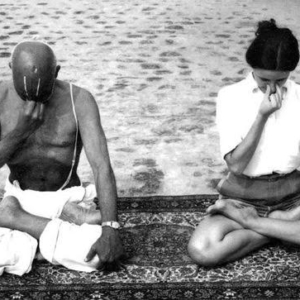Ritual Spotlight
Walking
“Most of the time walking is merely practical, the unconsidered locomotive means between two sites. To make walking into an investigation, a ritual, a meditation, is a special subset of walking, physiologically like and philosophically unlike the way the mail carrier brings the mail and the office worker reaches the train. Which is to say that the subject of walking is, in some sense, about how we invest universal acts with particular meanings.”
—Rebecca Solnit, Wanderlust: A History of Walking
An integral part of Hindu and Buddhist devotional practice involves circumambulation — “to walk in a circle around” sacred objects, deity images, or a holy place. The mechanics of motion are specific and important here. Orienting the physical body around a focal point reminds us to keep what’s sacred at the center of our lives.
From spiritual pilgrimages to personal odysseys, walking has always offered both poetic and practical relief, restoration, and resonance. Beyond the realm of sacred tradition, our mental states are altered when walking, especially in nature. Doctors are increasingly prescribing time outdoors to combat stress, an adaptation of the longstanding Japanese tradition, Shinrin-yoku, or “forest bathing.”
In a recent study at the University of Edinburgh, researchers used lightweight brain-scanning devices to understand the impact of green space on the mind. The results indicated that walking through busier, urban areas induced frustration and irritation in participants. Green space and parkland alternatively led to calmer and more meditative states. “Natural settings gently engage the brain while allowing it ample space to ruminate in the background on life’s quandaries and complexities. In other words, it lets your mind off the hook for a while; going for a walk allows your brain to roam along with your body.”
Walking is the primary mode of interaction we have with place: a means, but also — equally — a method. Akin to eating and breathing, to walk is to take in the world: “a reciprocal action, a gesture of exchange” —Robert Macfarlane, The Old Ways: A Journey on Foot. With every step forward — one foot in front of the other — walking renews our chance to move differently, to be different.
How to walk mindfully:
- Move slowly: “Slowness means cleaving perfectly to time, so closely that the seconds fall one by one, drop by drop like the steady dripping of a tap on stone. This stretching of time deepens space. It is one of the secrets of walking: a slow approach to landscapes that gradually renders them familiar. Like the regular encounters that deepen friendship.” —Frédéric Gros, A Philosophy of Walking
- Walk the perimeter of an imaginary shape to sharpen your propensity for precision. This works best on a beach or in an open field. We’re taking cues from shuudan koudou (“collective action”), a form of highly choreographed synchronized precision walking practiced in Japan.
- Engage the senses walking barefoot if you can. Take note of what you see, smell, taste, hear and touch as you put one foot in front of the other.
- Walk without a destination in reverence to the journey itself. “Thinking is […] best done by disguising it as doing something, and the something closest to doing nothing is walking. Walking itself is the intentional act closest to the unwilled rhythms of the body, to breathing and the beating of the heart. It strikes a delicate balance between working and idling, being and doing.” —Rebecca Solnit
Further Reading:
- Article: “How to be mindful walking in the rain”
- Article: “Take a Walk in the Woods. Doctor’s Orders.”
- Book: A Philosophy of Walking by Frédéric Gros
- Book: Wanderlust: A History of Walking by Rebecca Solnit
- Essay: Walking by Henry David Thoreau
- Poem: Camino by David Whyte

